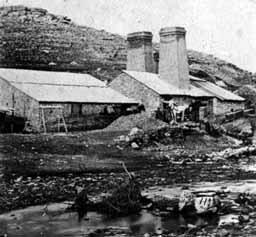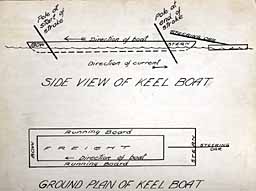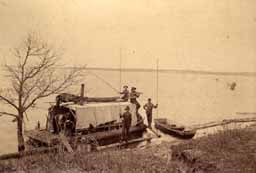

 |
 |
 Bruno Vinette |
Early Lumbering on the Chippewaby Bruno Vinette1
|
 Scotch hearth/blast furnace Galena Illinois 1850s |
It was in 1853, just seventy years ago, that as a young man I left my old home in Canada for the West. After spending two years in Kankakee, Illinois, through a man who had just returned from the "pineries" of the Chippewa valley in northern Wisconsin I became interested in that region. In the late summer of 1855, with a man by the name of Ben Dement, I started out. We went by train to Chicago and by train and mule team from there to Galena. At that point we took a steamboat to Reads Landing, at the mouth of the Chippewa. This was several years before steamboats began running on the Chippewa, but we found two raft crews about ready to start up river with a keel boat full of supplies. An average keel boat was perhaps sixty feet long, ten feet wide, and four feet deep. A "running board" about two feet wide extended full length of the boat on each side. The boats were propelled by poles. These poles were about sixteen feet long, light and strong, with a steel point on the lower end and a knob or button on the upper end. From twelve to twenty men were required to propel the boat. An ordinary Chippewa raft crew consisted of eight oarsmen and a pilot. It was a very common arrangement for two raft crews to pole a loaded keel boat up river and tow the boat down again with the next raft. On the keel boat one man acted as pilot and the others were equally divided on the two sides of the boat. |
 |
|
 |
 fiddle & pike poles on Mellow Lake |
 rafter with pike pole |
Taking their places at the bow, on the running board, with the steel points of their poles on the river bottom and the knobs pressed against their shoulders, the men in a stooping position walked to the stern. Raising their poles they quickly ran back to the bow to repeat the operation. Attached to the bow and coiled in the boat was a light, strong rope called a "cordil" [cordelle]. This was used for pulling the boat through deep channels and rapids where the poles were not sufficient. A big half-breed by the name of La Batte2 was pilot of the keel boat about to leave Reads Landing, and my partners and I made arrangements with him to work our passage up river. It was new work to both of us but we stood it all right; in fact, we made several more such trips that same season, and occasionally for several seasons more. |
 |
|
1 William W. Bartlett, of Eau Claire, interviewed Bruno Vinette and wrote the reminiscences as though the veteran logger had himself written them.
2 Either François La Bathe or one of his sons. The mother of François was a sister of the Sioux chief Wabashaw II.